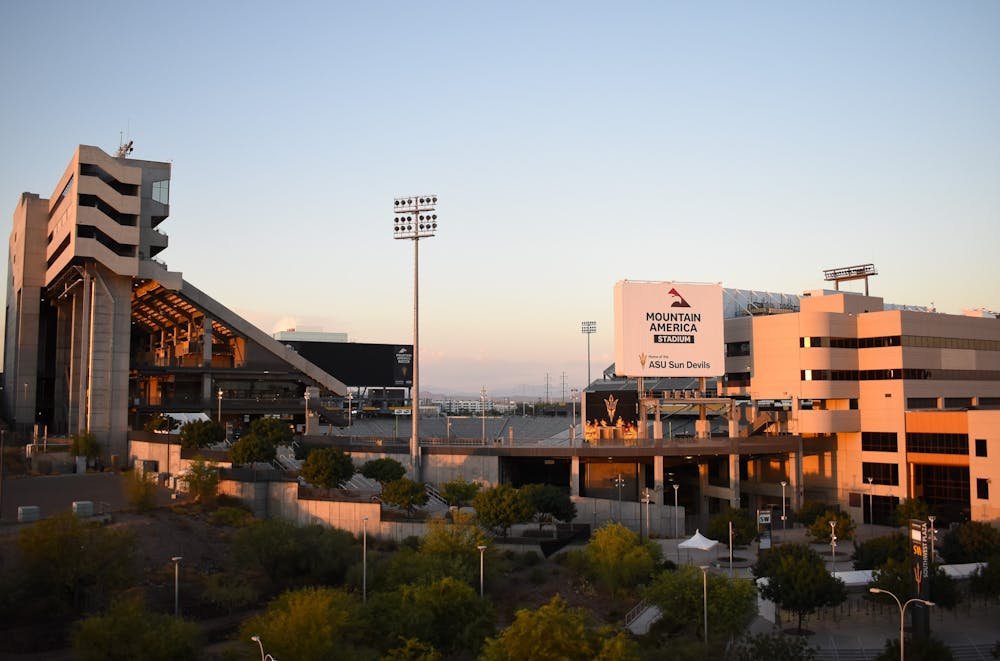Weather became the main event of ASU’s nail-biting opening night win over Southern Utah, which featured a nearly three-hour break in between halves due to a lightning delay and dust storm.
Although there are no storms forecasted for Saturday night’s crucial matchup against Oklahoma State, weather will certainly still be a factor. According to the National Weather Service, 105 degree temperatures are expected in Tempe for the game’s 7:30 p.m. kickoff, which, if it occurred, would be the third hottest game-time temperature in Mountain America Stadium history and the hottest game in ten years.
The extreme temperatures come after Phoenix endured a historically hot summer, including a July heat wave that led to the region’s hottest month on record and featured an average temperature of 102.7 degrees. Sky Harbor Airport, which takes the region’s official temperature measurements for the National Weather Service, tallied a record 31 consecutive days with temperatures above 110 degrees Fahrenheit in Phoenix from June 30 to July 30.
READ MORE: Phoenix endures historic heatwave, study says blackout would be catastrophic
In late July, ASU coach Kenny Dillingham was enthusiastic about the heat wave’s potential to provide a boon to ASU’s chances in the early-season heat.
"We need to play into it. We need to use it," Dillingham said in a July 31 press conference. "We need to embrace it, treat it as a teammate: Thank you, it’s hot outside today, I hope we play in this."
To Joe Connolly, head coach of football sports performance, ASU’s frequent and arduous practices in July’s blistering conditions were a key element in setting ASU up to be equipped for the heat in ways its opponents are not.
"We'll have games that are less challenging than some of the practices we've had, from an intensity perspective," Connolly said. "I think that’s extremely necessary from an adaptation perspective for the body."
READ MORE: Competitiveness and intensity highlight spring practice in new era of ASU football
Connolly, who worked in the south, northeast and midwest before coming to ASU, said players’ level of adaptation to heat is often a function of where they're from and their prior experience in extreme temperatures. Stillwater, Oklahoma — where Oklahoma State is located — averages a high of 94 degrees in July, nearly 9 degrees cooler than this July in Phoenix.
But ensuring players are acclimated to maintain both safety and performance in extreme temperatures takes more than intense practices. Much of the work to prepare individual players physically and mentally for hot early-season games originates off the field.
"A lot of it comes down to education," ASU Director of Football Athletic Training Gerry Garcia said, referring to diet and hydration regimens designed in part to mitigate the impact of heat on players' body and mind.
ASU’s unusually high number of transfers on this year’s team means more players who may have entered the program without much exposure to Tempe’s hot, dry climate, and whose resilience to those conditions must be monitored by the training staff. ASU has 29 incoming transfers on the team, the second most in Division I.
"As we have gone through workouts and practices we have noticed some guys that maybe are a little under-hydrated or maybe not eating enough," Garcia said. "It comes down to educating them as to things they can be doing better so they can perform at a higher level."
Garcia said ASU football has not had a single instance of heatstroke in his 11 years with the team.
Jason Siegler, director of human performance at ASU’s College of Health Solutions, said heat can exacerbate the existing challenges of preparing football players for college-level intensity.
"These guys are larger individuals. A lot of them are generating quite a bit of heat just with their normal activity, and the normal demands of the game," Siegler said. "You then compound that with the heat in the environment that might increase their sweat rates or might increase the physical load that they're experiencing."
Siegler continued that weight added by pads can contribute to heat retention, and that surface area, body fat index and fitness level can all impact a player's resilience to heat.
That's why Dillingham insists on maintaining such a high intensity level in practice despite the sweltering heat.
"The more adversity you can create in practice the better," Dillingham said. "Because that’s what a game is. You can’t simulate (game) adversity. The heat is an advantage."
Edited by Alexis Waiss, Sadie Buggle and Caera Learmonth.
Reach the reporter at awakefi3@asu.edu and follow @_alexwakefield on X.
Like The State Press on Facebook and follow @statepress on X.




